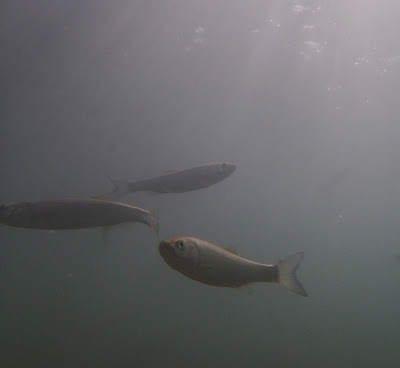 |
| The Melissourgiotikos Tributary of the Kalaritikos (Arachthos) in The National Park of Tzoumerka, Peristeri and Arachthos Gorge |
Mid September 2013
Ok, some trips you really remember, and this is a first-timer for us.
This is the first time HCMR officially has a project involving river science by observing fishes with mask and snorkel! And it is the first time any such fish-based micro-habitat suitability work has been officially researched by a scientific snorkeling method in Greece!
As most of my readers know, I love snorkeling. I have bought 7 mm thick wetsuits and used them in cold trout streams but I have never done a scientific survey using them. So now is the time - and our project is called EcoFlow!!!
Our Hellenic-Spanish field team finally got to do this amazing challenge: to attempt to use fishes and their habitat requirements for estimating environmentally-acceptable flow regimes below dams and water abstraction points. To do this right first you need to meticulously measure and understand the specific micro-habitat needs of the local fishes in natural conditions. We are concentrating our work on the mountain and upland streams in this multiple-partner project (funded by the Hellenic General Secretariat of Research and Technology). In four field days in mid September we inspected 12 sites in several upland tributaries of the Acheloos and Kalaritikos Rivers.
The fishes we observed in the mountain streams are the following:
- West Balkan Trout Salmo fariodes (Ioniki Pestrofa) - ENDEMIC to Western Balkans.
- Peloponnesian Barbel Barbus peloponnesius (Peloponnisiaki Briana) - ENDEMIC to Ionian Ecoregion.
- Epirus Riffle Dace Telestes cf. pleurobipunctatus (Liara) - ENDEMIC to Ionian Ecoregion.
- Peloponnesian Chub Squalius cf. peloponnensis (Potamokefalos Peloponnisou) - ENDEMIC to Ionian Ecoregion.
- Albanian Barbel Luciobarbus albanicus (Strossidi) - ENDEMIC to Ionian Ecoregion.
In this list I give the modern Greek names in parentheses, two of the scientific names have a cf code (latin for confer) meaning that we are not positive that this is a valid name since we know that these fish populations are under taxonomic review and their names may soon change. Also I should note that Albanian Barbel has never been recorded in Albanian territory and is a local Greek endemic, however although the name was given by a mislabeling mishap by the original collector I prefer to use the older colloquial name "Albanian Barbel" than the modern nickname of Strossidi used by Kotellat and Freyhof (2007). (We have a lot of Albanian people living in the Hellenic Peninsula for centuries so it is quite appropriate that a Greek Endemic fish have this amusing name - no problem...).
Upland rivers are threatened by hydroelectric dams and other barriers and by water abstraction (and even river diversion projects). Our EcoFlow-funded research aims to help us better restore and prescribe more natural flow regimes in degraded rivers. We begin with the most beautiful of Greece's waters - mountain waters!
I post some of our snapshots from this inception field survey. I thank field team members, Elias Dimitriou, Christina Papadaki and our good friend Fransisco Martinez-Capel (from the Polytechnic University of Valencia). For more updates about our recently launched mulit-partner project check http://www.ecoflow.gr/en/.
 |
| Dr. Martinez-Capel using the Go-Pro camera in a deep pool in the Upper Acheloos (near Gardiki Village). Water was about 10 m visibility here! |
 |
| Yours truly, just enjoying the beautiful colours and light in the Acheloos - soon this reach near Alexiou Bridge may be flooded by the Mesochora Dam...what a sad disgrace! |
 |
| West Balkan Trout (about 26 cm TL). A true survivor. Kamnaitikos Tributary of the Acheloos. Sadly many of these clear-water reaches are fiercely spear-fished by poachers. |
 |
| The Peloponnesian Barbel is sensitive to siltation and flow-regime changes. This is macro photo of a fry (<5 cm TL) at Gardiki Bridge on the Acheloos. |
 |
| Big trout caught in camara flash!! Note the many over-turned cobbles shuffled around by the great flood that happened in February here at the Kamnaitikos. |









